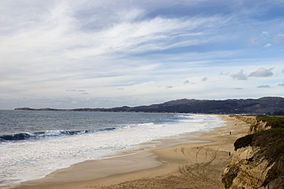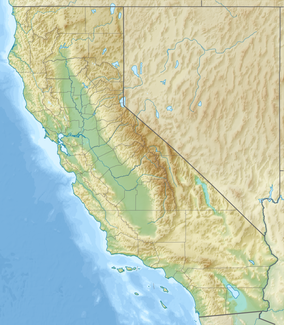Half Moon Bay State Beach
| Half Moon Bay State Beach | |
|---|---|

Half Moon Bay State Beach
|
|
| Location | San Mateo County, California, USA |
| Nearest city | Half Moon Bay, California |
| Coordinates | 37°28′26″N 122°26′55″W / 37.47389°N 122.44861°WCoordinates: 37°28′26″N 122°26′55″W / 37.47389°N 122.44861°W |
| Area | 181 acres (73 ha) |
| Established | 1956 |
| Governing body | California Department of Parks and Recreation |
Half Moon Bay State Beach is a 4-mile (6 km) stretch of protected beaches in the state park system of California, USA, on Half Moon Bay. From north to south it comprises Roosevelt, Dunes, Venice, and Francis Beaches. The 181-acre (73 ha) park was established in 1956.
The broad, sandy beaches are used for sunbathing, fishing and picnicking. A campground provides accommodations for those who wish to visit longer. This Pacific Ocean beach, located immediately south of Pillar Point Harbor and the town of Princeton-by-the-Sea, is often used by surfers, who utilize its unusual waves that are influenced by reflective action from the harbor jetty. At the north end of the bay there is a county park in the lee of Pillar Point Harbor with a well-maintained trail that allows hikers and bikers access to the ocean below the point. Some of the tallest surf in California occurs offshore of Pillar Point following big storms. The area is well known as Mavericks and is famous for the annual Mavericks Surf Contest.
Francis Beach has a campground with 52 individual sites; some sites are more suitable for tent camping, others for trailers or recreational vehicles. RV hookups are not available, but there is a dump station.
The Native American culture of the Ohlone people lived along the San Mateo County coast for many thousands of years, in small and scattered villages because of the limited availability of food. The native way of life rapidly changed during the late 18th century when the first Europeans arrived.
The first European land exploration of Alta California, the Spanish Portolà expedition, passed through the area on its way north, camping on October 28–29, 1769 near the shore either at Frenchman Creek or Pilarcitos Creek, both of which reach the bay along this beach. Franciscan missionary Juan Crespi described nearby Pillar Point in his diary, "In this place there are many geese, and for this reason the soldiers named it the plain of 'Los Ansares'. From the camp the...point lies to the north-northwest, and the high rocks look like two thick Farallones [rocky islands] of an irregular and pointed shape."
...
Wikipedia


